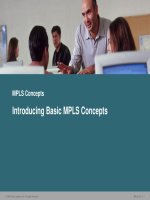Computers and digital basic computer concepts 2014 chapter10
Bạn đang xem bản rút gọn của tài liệu. Xem và tải ngay bản đầy đủ của tài liệu tại đây (2.72 MB, 58 trang )
Chapter 10
Information Systems
Analysis and Design
Computer Concepts 2014
10 Chapter Contents
Section A: Information Systems
Section B: Systems Analysis
Section C: System Design
Section D: Implementation and Maintenance
Section E: Corporate Data Security
Chapter 10: Information Systems Analysis and Design
2
10 FastPoll True/False Questions
Answer A for True and B for False
100100 Tactical and operational planning define long term
goals for an organization.
100200 When managers encounter unstructured problems, a
transaction processing system can usually supply the answers.
100300 An OLTP system processes transactions in real time as
they are entered.
100400 An ad hoc report is a customized report that provides
information not available in regularly scheduled reports.
100500 An expert system uses a knowledge base and
inference engine.
100600 An SDLC provides a general outline of how an
information system evolves.
Chapter 10: Information Systems Analysis and Design
3
10 FastPoll True/False Questions
Answer A for True and B for False
100700 System requirements are also called success
factors.
100800 DFDs and UML are used to document information
systems.
100900 Unit testing is a process that tests all the hardware
and software components of an information system to make
sure it performs according to specifications.
101000 Throughput refers to the amount of data processed
in a particular time interval.
101100 MTBF refers to the average time between failures of
a hardware component.
Chapter 10: Information Systems Analysis and Design
4
Section
A:
10
Information Systems
Information Systems in Organizations
Transaction Processing Systems
Management Information Systems
Decision Support Systems
Expert Systems and Neural Networks
Chapter 10: Information Systems Analysis and Design
5
10 Question
102100 Information systems are classified based on the type
of information they collect and provide. What types of
information systems are you as an average consumer likely
to interact with?
A. Transaction processing systems and expert systems
B. Management information systems and transaction
processing systems
C. Decision support systems and executive information
systems
D. Expert systems and neural networks
Chapter 10: Information Systems Analysis and Design
6
Information
Systems
in
10
Organizations
An information system collects,
stores, and processes data to
provide useful, accurate, and
timely information
An organization is a group of
people working together to
accomplish a goal
Business
Nonprofit organization
Mission
Mission statement
Chapter 10: Information Systems Analysis and Design
7
Information
Systems
in
10
Organizations
Organizational charts depict the hierarchy of
employees in an organization
Chapter 10: Information Systems Analysis and Design
8
Information
Systems
in
10
Organizations
Information systems can:
Automate routine tasks
Make decisions in response to problems
Structured problem
Semi-structured problem
Unstructured problem
Collect and store internal or external information
Chapter 10: Information Systems Analysis and Design
9
Transaction
Processing
10
Systems
Provide a way to collect, process, store, display,
modify, or cancel transactions
Payroll, accounting, airline reservations, inventory, point
of sale and cellular phone billing
Batch processing vs. online processing
OLTP system
Commit or rollback strategy
Detail reports
Chapter 10: Information Systems Analysis and Design
10
Transaction
Processing
10
Systems
Chapter 10: Information Systems Analysis and Design
11
Management
Information
10
Systems
Chapter 10: Information Systems Analysis and Design
12
Management
Information
10
Systems
Chapter 10: Information Systems Analysis and Design
13
10 Decision Support Systems
Helps people make decisions by directly
manipulating data, analyzing data from external
sources, generating statistical projections, and
creating data models of various scenarios
Executive information system
DSSs design decision models and make decision
queries
Chapter 10: Information Systems Analysis and Design
14
10 Decision Support Systems
Chapter 10: Information Systems Analysis and Design
15
Expert
Systems
and
Neural
10
Networks
Expert systems are designed to analyze data and
produce a recommendation, diagnosis, or decision
based on a set of facts and rules
Knowledge base
Inference engine
Knowledge engineering
Expert system shell
Fuzzy logic
Neural networks use computer circuitry to simulate
how a brain may process info, learn, and remember
Chapter 10: Information Systems Analysis and Design
16
Expert
Systems
and
Neural
10
Networks
Chapter 10: Information Systems Analysis and Design
17
10 Section B: Systems Analysis
System Development Life Cycle
Planning Phase
Analysis Phase
Documentation Tools
Chapter 10: Information Systems Analysis and Design
18
10 Question
102200 If you are participating as a member of a team on a
project to upgrade an information system, what can you
expect the team to accomplish first?
A. Complete the systems analysis and design according
to the systems development life cycle.
B. Complete the planning phase to devise a Project
Development Plan.
C. Complete the analysis phase to produce the Systems
Requirement document.
D. Complete the documentation of the current system
using DFDs or object-oriented documentation tools.
Chapter 10: Information Systems Analysis and Design
19
System
Development
Life
10
Cycle
Systems analysis and design is a discipline that
focuses on developing information systems
according to the phases of an SDLC
Chapter 10: Information Systems Analysis and Design
20
10 Planning Phase
Assemble the project team
Justify the project
Choose a development methodology
Develop a project schedule
Produce a Project Development Plan
Chapter 10: Information Systems Analysis and Design
21
10 Planning Phase
Justification for new system usually emerges from a
serious problem with the current system, a threat to
the organization’s success, or an opportunity to
improve an organization’s products or services
through technology
Chapter 10: Information Systems Analysis and Design
22
10 Planning Phase
An organization must be able to:
Make improvements
Change the industry
Create new products
The PIECES framework helps classify problems in
an information system
Chapter 10: Information Systems Analysis and Design
23
10 Planning Phase
Development methodologies
Structured methodology
Information engineering methodology
Object-oriented methodology
PERT (Program Evaluation and Review Technique)
WBS (Work Breakdown Structure)
Gantt chart
Chapter 10: Information Systems Analysis and Design
24
10 Planning Phase
Chapter 10: Information Systems Analysis and Design
25









